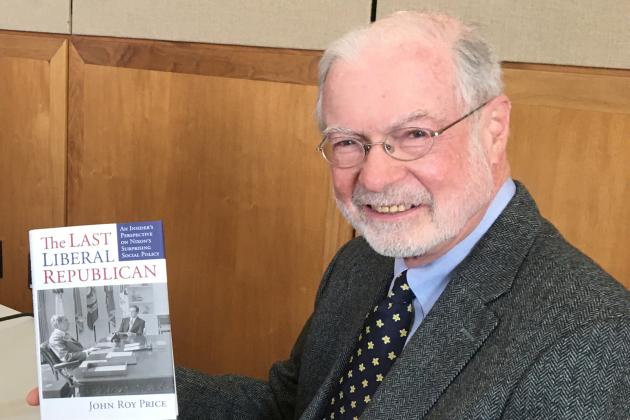|
WEDNESDAY, FEBRUARY 26, 2003 |
|
| 8:30 A.M. | Registration and Continental Breakfast |
| 9:00 A.M. | Opening Remarks by John Raisian Director, Hoover Institution |
| 9:15 A.M. | Remarks by the Honorable Rod Paige U.S. Secretary of Education |
| 10:00 A.M. | Findings and Recommendations, Koret Task Force on K–12 Education |
| 11:15 A.M. | Panel Discussion Lamar Alexander, U.S. Senator (R-TN) Milton Goldberg, Education Commission of the States |
| 12:15 A.M. | Symposium adjourns |
Remarks of the Honorable Rod Paige United States Secretary of Education Thank you, Kurt, for that introduction. I am so pleased to be here among such a distinguished group of scholars, and many of you are old and distinguished friends. It's good to see all of you. I want to thank my good friend Bill Evers for inviting me here today. Tennessee has sent a truly impressive lineup of Tennessee Titans to the U.S. Senate in the last half century, and now they've got another: former governor and my predecessor, Lamar Alexander. Lamar has long been a champion of education and continues to work hard for America's children by now serving on the Senate Health, Education, Labor, and Pensions Committee. It's always good to see you, sir. Finally, I want to thank all the members of the Koret Task Force. You are to be commended for your vigilance and concern for America's children. This study, Our Schools and Our Future—provides important insights into the education challenges we face as a nation and the work we do every day at the Department of Education. As we all know, that work that took on a new sense of urgency back in 1983. Back then, a stamp cost 20 cents. The Big Chill was the big movie of the year. And "Blackberries" were still something you ate in a cobbler. We were a nation at peace who'd watched in wonder at the birth of democracy in Poland and who now hailed the year's recipient of the Nobel Peace Prize—Poland's future president, Lech Walesa. There was no cell phone service, no high-speed Internet. So when the Department of Education dropped a little blue-and-white bomb called A Nation at Risk, the shockwaves rippled far and wide the old-fashioned way. The news hit the front page of papers. It headlined the evening news. It became the main topic of conversation around office water coolers. People who had not given much thought to our nation's education system suddenly sat up and listened. And what they heard scared them: Generations of young people in our public schools had tumbled—virtually unnoticed—through gaping holes in the system, victims of low standards and low expectations. This report warned that by the turn of the century, millions of jobs would involve high technology and we risked not being prepared for our own future. With the clinical precision of a surgeon, the report laid out the diagnosis: "If an unfriendly foreign power had attempted to impose on America the mediocre educational performance that exists today, we might well have viewed it as an act of war." But no one had done this to us. We only had ourselves to blame. A Nation at Risk set off a wave of well-intentioned school reform efforts. In the ensuing decades we saw trillions of dollars, formal standards, and lots of effort applied to the problem like bleach on a tough stain. But what we didn't see was a solution. The achievement gap grew wider. Test scores stayed flat. And a disturbing trend emerged: The longer students stayed in school, the farther behind they fell academically. And so as the years progressed, thousands more children—mostly poor and mostly minority—dropped through the cracks to uncertain futures on the margins of society. Like a giant game of crack-the-whip, everyone felt the impact. Employers faced difficulties finding workers with basic skills. Unskilled workers who couldn't get jobs faced difficulties making ends meet. Communities faced growing numbers of people in need of public support and services. On and on it went. By the time President Bush took office, the situation was truly sobering: • Two out of three fourth graders couldn't read proficiently. • Seven out of ten inner-city and rural fourth graders couldn't read at the most basic level. • America's twelfth-graders ranked among the lowest in math and science achievement among their counterparts around the world. As President Bush stood in front of the Capitol and took the oath of office, he knew our nation faced an urgent challenge. He believed that education is a civil right, just like the right to vote or to be treated equally. And it's the duty of our nation to teach every child well, not just some of them. Yet in the greatest, most prosperous nation in the world, we had created two education systems—separate and unequal—that found it perfectly acceptable to teach only some students well while the rest, mostly minority and mostly low income, floundered or flunked out. In his inaugural address, President Bush called upon our nation to "show courage in a time of blessing by confronting problems instead of passing them on to future generations." Together," he said, "we will reclaim America's schools, before ignorance and apathy claim more young lives." His first day on the job, President Bush called together a panel of educators and began the task of fundamentally changing the structure of education in America. Then the unthinkable happened on September 11, 2001. But even in the aftermath, as the president worked to build an international coalition to fight terror, he stayed focused on working to build a bipartisan congressional coalition to improve our schools. The result was the No Child Left Behind Act of 2001—a remarkable consensus by both parties in both houses of Congress that the time had come to make every school in America a place of high expectations and high standards. Where A Nation at Risk envisioned reform from the top down, President Bush envisioned reform from the bottom up—in grades K through 12—where it can do the most good. No Child Left Behind not only provided historic levels of funding to get the job done, it created a framework for change by • Insisting that schools be held accountable for student performance • Insisting on instruction that science tells us really works and helps children learn • Empowering parents with options and choices if their children aren't learning • Insisting that every child in our public schools learns by third grade the one skill upon which all others are based: reading, no excuses No Child Left Behind also insists on quality teachers in every classroom who not only know deeply the subject they're teaching but who really care about the job they do. If you were watching CBS's Sunday Morning last weekend, you may have seen Dr. Amar Bose, the MIT professor who invented the famous stereo system. He was talking about teaching, and he said something he had learned over the years was, and I quote, "The students will rise, not to your expectations, but above them—if they know you care." We are blessed in this country to have many great teachers and principals who are the quiet heroes in our nation's classrooms. General Omar Bradley called teachers the little soldiers of democracy. Unfortunately, there are some who think the children in their classroom cannot learn because they are too poor or too disadvantaged or too fill in the blank. I think of the elementary school principal—from Webster Elementary School in Mesa, Arizona—whose op-ed recently appeared in the Atlanta Journal-Constitution. It began with these words: "Educators know the truth but are afraid to say it: All children cannot learn." Now what chance have those kids got in that man's school? The research is clear: Teachers' attitudes affect student achievement. And children—across the demographic spectrum—show the greatest achievement gains when they have teachers who really believe they can learn. This scenario is being played out in schools all across our nation • Places like the KIPP academies that have taken so-called lost causes and turned them into scholars • Places like Waitz Elementary School in Mission, Texas, where migrant farmers' children are scoring higher than their peers in more well-off suburbs • Places like Samuel Gompers High School in the Bronx, in the district with the lowest per-capita income in the nation, where the majority of the graduates go on to college No Child Left Behind is historic in its sweep, its funding, and its commitment to our children. Never before has this nation made the commitment to educate every child, regardless of race, family income, or zip code. And I'm proud to say that we are making good progress in implementing these monumental reforms. For the first time in the history of public education, all states have submitted accountability plans to show how they intend to improve student achievement, keep parents informed, and provide options for children who aren't learning. And we are working hand in hand with the states to help ensure their success because we know the stakes are high. One child left behind is one child too many. But we still have much more work to do. A major report suggests our lost ground on the education front poses a national security risk "of the first order." The report—titled Road Map for National Security: Imperative for Change—was issued by the bipartisan U.S. Commission on National Security/21st Century that was cochaired by Warren Rudman and Gary Hart. Among their many observations was this one: "Second only to a weapon of mass destruction detonating in an American city, we can think of nothing more dangerous than a failure to manage properly science, technology, and education for the common good over the next quarter century." This statement has even more meaning today than when it was written in February of 2001. Right now, our nation faces the real possibility of war. I have known the president a long time. And I can tell you that he does not relish the idea of sending someone's son or daughter into harm's way. War is not a matter he takes lightly. He is peaceful leader who is facing down a hateful dictator. So whatever action is required, whenever action is necessary, I can assure you that President Bush will defend the freedom and security of the American people. And we as a nation need to be ready at all times, in all ways. We have already exceeded the high-tech-someday that A Nation at Risk envisioned. We need look no further than our morning paper to see that our future—and the future of our children—is inextricably linked to the complex challenges of the global community. So in this complex and sometimes uncertain world, it is paramount that America graduate greater numbers of well-educated young people. Our future depends on them to lead the way in developing strategies and technologies that will keep us safe and prosperous for generations to come. A rising tide lifts all boats, and nowhere is that more true than here. By raising the bar for achievement in our nation's schools, we raise the quality of high school graduates. And that increases the number of students capable of winning admission to the college of their choice, based on their talent and potential—not admissions quotas and double standards. A Nation at Risk was a much-need clarion call to action. It spoke boldly about the condition of our nation's schools—and the past and future harm the system held for our children. But—as the Koret Task Force points out in its new report this morning—it misjudged how to fix the problem. I believe we now have the answer in No Child Left Behind. And I believe our new education reforms provide the accountability, choice, and transparency that the task force saw lacking in previous efforts to address the concerns of A Nation at Risk. Despite what that principal in Arizona thinks, this is a great time to be an educator. Some people work a lifetime and never get the chance to be a part of something historic that will leave its mark for all time. Now it's up to us to stay focused on the task and to do whatever it takes to help every child learn, so no child is left behind. Thanks and I'll take your questions now.









